Final of the Battle of Yaroslav. Will we hold onto Sana'a?
The 7 of May was replaced by the command of the 3 Army: General of the Infantry L. V. (P.) Lesh became the army commander and a new army chief appeared a little later.
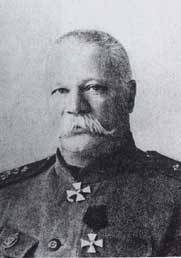
At the end of the operation
On this day, the operation fades.
The left flank of the 3 Caucasian Army Corps (52 Infantry Division) retreated to Dobrcha. In fierce battles from 5-th to 7-th, the division did not manage to eliminate the bridgehead on the right bank of the river. San y D. d. Lezhakhov and Chertse. The division suffered significant losses. For example, on May 7, the commander of the 206 Infantry Salyan Heir, Cesarevich, regiment was commander of the Order of St. George 4, Colonel V.V. Zaitsev, was killed.
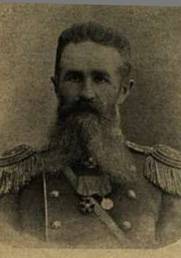
The right flank of the 24 Corps again took up positions at the turn of the Houle - Falcons - Zenke - Tsetula. The 3-I Caucasian Rifle Division occupied positions in the Menkish Stary, while the 2-I squadron brigade - in Menkish New, and the 1-I squadron - in Velky Ochi on the left flank of the army.
The 5-th Caucasian Army Corps was given a combat sector from the eastern outskirts of Makovysko to Vetlin. The consolidated corps was disbanded - in connection with the departure of parts of the 77 Infantry Division to Molodich.
The reserves of both the army and the front were spent - “The 5 Caucasian Corps has already been put into operation, just like the 77 Division; his last reserve - the Plastun Brigade - the commander-in-chief sent to reinforce the consolidated corps and the 24-th to cover the retreat to the right bank of Sana 21-th and 22-th corps ... ".
The chief of staff of the front told the command of the 3 Army "the opinion of the Commander-in-Chief," which was to concede to the enemy as little as possible of the occupied space, and to yield only under the pressure of the circumstances of "extreme necessity" and having exhausted all possibilities for defending the "busy". The basis of the actions of the armies of the South-Western Front was not an operational maneuver, but a struggle for space and submission to the will of an actively operating enemy. In the armies of the 3 and 8 armies, orders were given “to hold firmly, without departing a single step back” and “to hold fast in places.” It was decided to defend Przemysl.
The final directive of the commander-in-chief of the armies of the South-Western Front ordered: “The immediate tasks for the armies of the front are to persistently defend every inch of land, so that, having exhausted the enemy and having regrouped the forces that are more consistent with the current situation, go over to the offensive; 4-I and 3-I armies provide directions to Brest, Vladimir-Volynsk, acting in close connection with each other. 8-I, 11-I, 9-I armies are based on the Kiev military district ".
3-I army should have been deployed from p. Bystritsy on r. Pore and upper reaches. Veprzha to Krasnobrod - Narol inclusive, and 8-I army - from Narol to Komarno inclusive.
In the 20 hours of 7, the new commander of the 3 army issued an order in May, which established that with the onset of darkness the 3-th Caucasian Rifle Division was to replace the XovUM-Siberian and 12-th Infantry Division in the Makovisko-Vetlin sector. The corresponding section is entrusted to the commander of the 77 of the Caucasian Army Corps, both of the last Plastun brigades of the latter concentrated in the area of Korzhents - Brzezin, in the army reserve. The order prescribed during the occupation of the Makovisko-Vetlin sector to pay special attention to the tight holding of Veetlin and close combat contact with the 5 corps.
The brigade of the 77 division released after the change should be sent that same night to the commander of the 24 Army Corps - in order for the brigade to cross the sector to Cheturbok in the dark (then she was entitled to at least 5-hour rest). The movement of the brigade from Cheterboki was already led by the commander of the 24 corps. The 12-I Siberian Rifle Division, also released after the shift, was concentrated at night in Zapalove. Together with the 45 division (it occupied a sector from Tsetul via Ol'khov to Makovisko), the Siberian 12 formed the 29 corps, under the temporary command of which General Sulimov entered. The corps, previously occupied by the 45 division, is entrusted to the corps.
The commander of the 24 Army Corps, who received the 77 Division, had to take all necessary measures to stop the enemy’s advance between the right flank of the 24 and the left flank of the 3 Caucasian corps. Since the 24 corps had to operate in the forests, it was ordered to actively use machine guns in the glades, and the forest had to be brought to the maximum impassable state by organizing rubble and abutments. The full 9 Infantry Division, together with the section occupied by it, was immediately transferred from the 3 Caucasian Corps to the 10 Corps.
This order introduced the organizational order, and the defense sections were distributed among the corps more evenly, but they did not set operational tasks - the main thing was to hold their positions. The only active task was to dispose of the 24 body - to restore the position on the right flank. This should have led to the restoration of the left flank of the 3 Caucasian Corps.
The battle ended - the corps of the 3 Army was no longer trying to break through to the other side of the river. San and to Yaroslav, waiting for the next operational attacks of the enemy.
Some results
L. von Rotkirch summed up the results of the operation, which are very significant for the enemy: “Until the evening of May 20 (everywhere in the quote - a new style - A. O.) we crossed the river for 30 kilometers, threw the Russians out of Sinyavi and kept, despite the massive assault of the Russians, the eastern bank of the river. ... In the eyes of His Majesty the German Emperor, the Guards, Austrian and Hungarian regiments were at the height of their vocation. The emperor hurried to his troops, and on May 17 came to them by car, welcomed by the road transported by the wounded with loud cries of "Hurray." The wounded recognized the imperial car by the yellow standard fluttering on it. Mackensen's army ... crossed the river three times, beating the depth of 100 kilometers as a result. It was a huge success. ”
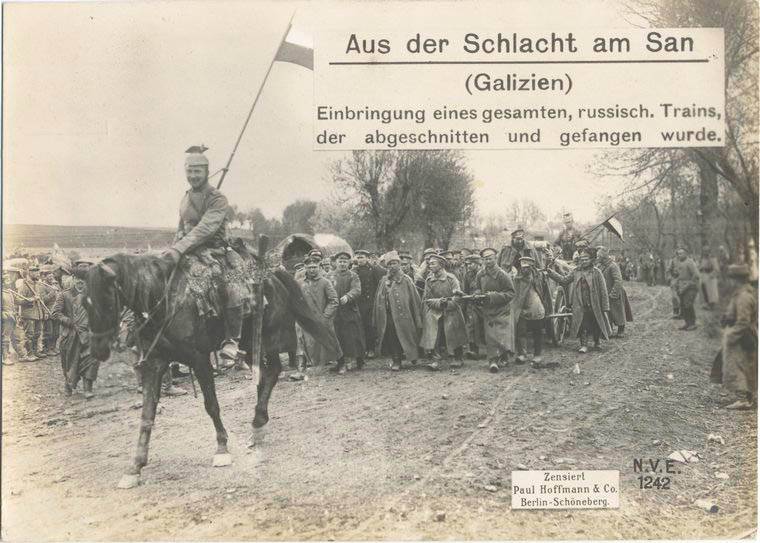
As well as other battles during the Gorlitsk operation, battles at Yaroslav and on the r. San abounded with tactical blunders of the Russian command.
While A. Mackensen again hit the Russian defense with a “fist”, the command of the Russian 3 Army “smeared” its defense along the r. San Despite the valor of the remnants of the army, the cordon location of its corps, the lack of reserves and the passivity of the command did not leave the Russian troops a chance for operational success. The Supreme Commander’s headquarters put pressure on the leadership of the front, defining the principle: “not one step back by all means”. The commanders and the 3 Army and the South-Western Front were well aware that the enemy would not be able to create a solid defense along the r. San, but were forced to obey. The aforementioned goal set by the Supreme Commander paralyzed the military creativity of the commander of the South-Western Front, which in fact turned into an extraordinary observer. The desire to fight for the retention of space justified just the cordon location of the armies and their corps and excluded the use of maneuver. The operational maneuvering of the Russian corps and armies was extremely limited, which was explained both by the fulfillment of the installations of the High Command and the loss of the operational-strategic initiative.
On May 3, the Supreme Commander requested the command of the South-Western Front: “Isn't it possible to allocate a maneuverable group to the greatest possible force from the 8 Army and strike these forces from Peremyshl on the flank of the enemy troops advancing on Yaroslav and Radymno? If necessary, I allow you to use the approaching division of the 5 Caucasian Corps, but I ask you to use it together. I believe ... that the situation on the right flank of the 3 Army could be facilitated and improved by active actions on the part of Rozvadovsky tet-de-pon, provided that it had two or three divisions from the 4 Army. ” The installation is absolutely correct, but, on the one hand, under the influence of casualties, the troops lost their maneuverability, and on the other hand, the High Command itself put the fetters on the operative work of subordinates.
Dranomirov Project
Of particular interest is a letter from the Chief of Staff of the South-Western Front, Lieutenant-General V. M. Dragomirov, to the Chief of Staff of the Supreme Commander-in-Chief — it not only provides an operational and strategic assessment of the situation on the South-Western Front, but also suggests practical measures to overcome the crisis.
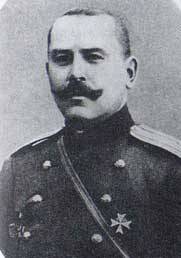
Vladimir Mikhailovich noted the hopelessness of the strategic position: the Russians occupied an extremely long position without the ability to transfer their forces with the desired speed. Moreover, the weakening of the armies of the South-Western Front made them even more immobile. The prevailing views on the maneuver did not allow the possibility of withdrawal for the collection and concentration of forces - although, as the letter noted, only such actions often allowed to avoid defeats in parts (as in the case of the 3 army at the end of September 1914). Disadvantages of a linear arrangement doomed the defenders to enemy strikes, and, as a result, more or less large defeats in one or another sector. A significant part of the army was constrained by actions in the mountains. Russian troops are fighting hard, holding to the last extreme - but this only entails an excessive breakdown of troops.
The army, according to the author, first of all needs to be replenished quickly, and with a high-quality contingent, for the arriving poorly trained and almost unarmed people are largely useless. The General proposed the following measure: to infuse the entire cash composition of the reserve battalions (even with the risk of completely upsetting them) into the army in the form of organized units, along with weapons and officers. He proposed the corresponding measure in telegram number 5868 from 25 of April. And we should immediately proceed to the new organization of these battalions.
The possibility of losing Peremyshl should be reconciled, not seeking to turn it into a battle-worthy fortress — there is currently no time or money for this. Instead, make every effort to strengthen and supply Brest, preparing him to meet with the enemy.
Rovno, Kiev, Cherkasy, Mogilyov, Kremenchug and the lines along the Styr, Ikva, Pelkva, Smotrich, Bug, Sluch, Dniester and Dnieper rivers should be strengthened.
The author of the letter pointed to the urgent provision of the army with ammunition “on a large scale” - for precisely this would allow to restore a stable position while continuing the struggle.
Finally, it is necessary to urgently develop a plan of action and firmly adhere to the latter. The general pointed to the danger of the 4 Army position, which, if the enemy broke through to the lower San, could become very dangerous. At the first sign of this, a quick departure to the Vistula is necessary. He shrewdly noted that as soon as the pressure of the Austro-Germans in Galicia ended, its front would be broken.
V.M. Dragomirov urged to work for the future - not only considering the present, but also calculating possible future prospects. After all, belated measures are not only useless, but can also be dangerous.
The main reasons for the deterioration of the Russian army’s maneuverability are poor organization of communications and linking armies to geographic points and certain positions.
Project Danilov
Yu. N. Danilov proposed a project of creating a special maneuverable army, which was supposed to concentrate in the rear of the Southwestern Front and become the backbone of the departing 3 and 8 armies: “It seems that it would be useful to assemble in the Rava Russkaya region, Tomashov army , which could serve as a support for maneuver, if we are forced to fold the flanks of the 3 and 8 armies back. If this idea seems appropriate to you, then is it not appropriate now, having joined the 22 and 18 corps to the 9 army, to transfer General Shcherbachev (Infantry General D. G. Shcherbachev - Commander of the 11 Army of the Southwestern Front) with his offices in Ravu Russkaya, where he could immediately organize the strengthening of the area called Rava Russkaya, Tomashov and receive suitable troops. Of course, the 2 of the Caucasian Corps and the 20 of the Infantry Division are not enough for this; maybe it would be timely to think about transferring one or two corps from the 9 Army through Lviv. ”
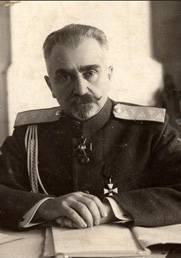
But transport communications did not allow to implement this rather interesting project at the right time.
Results
It seems that, in conditions of limited maneuverability, the 3-I army, as most affected during the Gorlitsky breakthrough, could well, tearing away from the enemy, to establish a reliable defense and, taking equipped positions, become the axis, the pivot for maneuvering other armies of the South-Western front .
Retreating from the Visloka, the 3 Army did not manage to win space, break away from the enemy pursuing it, and, accordingly, it had enough time to bring itself in order, at least accelerated manning, replenishment of ammunition and elaboration of the defense system on the approaches to . San, it was not. The forced retreat on pp San and Dniester significantly undermined the combat capability of the armies of the Southwestern Front (and especially the 3 Army). The troops of the South-Western Front should independently carry out a bold maneuver march, break away from the enemy, and move beyond the immediate pressure of the pursuing enemy. This, in particular, would have attempted to impose its will upon the enemy.
As a result, occupying the 110-kilometer combat area along the front, the five corps of the 3 Army, weakened by previous battles and stretched into a line, were supposed to detain the enemy, who was intently plowing in one direction - on the plot of the 24 Army Corps. In such a situation, the defense required not just a strong reserve, but the presence of a maneuverable strike group - but there was no corresponding reserve.
At the same time, the enemy, massaging forces and means in the direction of the main attack, successively struck first with the 3 and then with the 8 army, whose corps, under the influence of high losses in fire battles, gradually failed. Superiority in heavy artillery greatly facilitated the task of the enemy, who skillfully applied the operational maneuver.
A large influence on the failure of the 3 Army, in addition to the lack of reserves and weak maneuverability of troops, had organizational confusion. First of all, this concerned the mixing and "unraveling" of parts and formations, including those being transferred to the army as reserves. And although the leadership of the 3 Army received the following prescription: “The Supreme Commander transfers the entire 5 Caucasian Corps at your disposal with the sole indication not to scatter it in parts,” the corps was ripped off, forming the Consolidated Corps and “plugging holes” on front of the army. And only at the end of the operation, he acted on the r. San
Confusion has touched and personnel issues. Thus, the Order of the 3 Army Commander dated 5 on May 10 for 55 minutes instructed the commander of the 3 Caucasian Army Corps general from artillery V.A. Irmanov: for taking command over the Consolidated Corps. The command of the 3 Caucasus Corps is that the army commander orders the surrender to General Artemyev (Lieutenant-General V.V. Artemyev - Head of the 52 Infantry Division - A. O.) the corps headquarters must remain under General Artemyev. " But already in the 11 hours of 37 minutes an order was issued, which handed over the command of the Consolidated Corps into the hands of the commander of the 5 Caucasian Army Corps: “Istomin was appointed as commander of the Consolidated Corps 1702 operational order. day personally received from the commander of the army detailed instructions on the impending offensive. "
The change of command of the 3 army during a combat operation is also a step that is considered ambiguously.
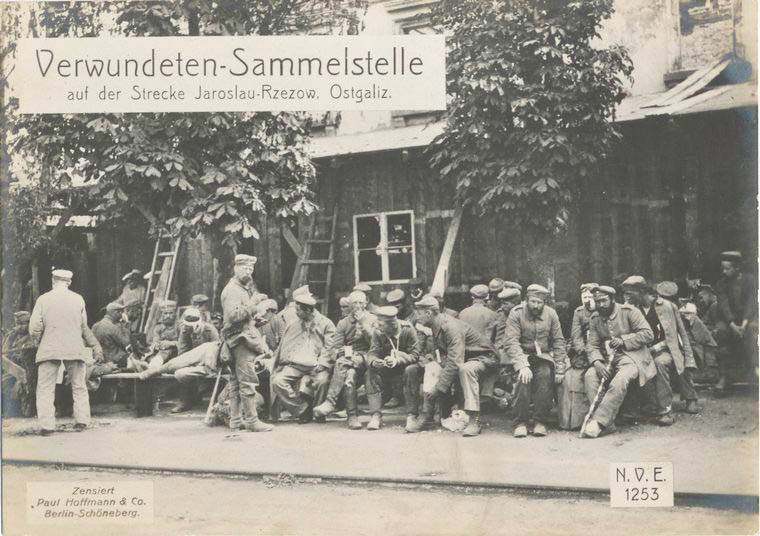
At the same time, the Germans and the Austrians were forced to suspend their offensive - the enemy was exhausted. Thus, as a result, as far as possible, the vigorous opposition of the Russian troops, the outlined plan of action of the Germans and Austrians on the river. San was ripped off. And the subsequent development of operations in the South-Western Front acquired a completely different color, which was of great importance for disrupting the planning of the Austro-German command during the spring-summer campaign of 1915.
Sources of
RGVIA. F. 2007. Op. 1. D. 42. H. 4; D. 48. H. 1; D. 54. H. 1;
Collection of documents. Gorlitsky operation. M., 1941;
Year of war from 19 July 1914 g. To 19 July 1915 g. M., 1915;
Chronicle of war. - 1915. - № 38, 39;
Österreich-Ungarns Letzter Krieg 1914 -1918. Bd ii. Wien, 1931;
Reichsarchiv. Der Weltkrieg 1914 - 1918. Bd 7. Berlin, 1931;
Reichsarchiv. Der Weltkrieg 1914 - 1918. Bd 8. Berlin, 1932;
Falkengayn E. background. 1914 High Command - 1916 in its most important decisions. M., 1923;
Hoffman M. The war of missed opportunities. M. - L., 1925;
Stepun F. From the notes of the ensign-artilleryman. Prague: Flame, 1926;
Brusilov A. A. My memories. M., 1983;
Ludendorff E. background. My memories of the war 1914 - 1918 years. M. - Mn., 2005;
Washburn S. The Russian campaign. April to august 1915. London, 1915.
Literature
The composition of the German mobilized field corps, cavalry divisions and reserve corps. Printing Office of the Supreme Commander, 1915;
Battle schedule of the Austro-Hungarian army. Compiled from data available in the Intelligence Division of the Headquarters of the Commander-in-Chief of the armies of the South-Western Front to 25 in May 1915. B. m., 1915;
Great War. 1915 year. Essay main operations. Russian Western Front. Pg., 1916;
Rotkirch L. T. Fon. Breakthrough of the Russian Carpathian Front at Gorlitsy-Tarnov in 1915, Pb., 1921;
Strategic essay on the 1914 war - 1918's. CH 4. M., 1922;
Ritter H. Criticism of World War. Pg., 1923;
Yu. N. Danilov. Russia in World War 1914 - 1915 Berlin, 1924;
Bonch-Bruevich, M.D., Our loss of Galicia in 1915, Part II. M. - L., 1926;
Kersnovsky A. A. History Russian Army. Tt. 3-4. M., 1994;
D. Lobanov, L. Oschepkov. History of the 194 Infantry Troitsko-Sergievsky Regiment. Perm, 2006;
Kibovsky A., Leonov O. 300 years of the Russian marines. T. 1. (1705-1855). M., 2008;
Participate in the War (1914-1918). Washington, 1920.
- Oleynikov Alexey
- The struggle for the initiative in the battle of Yaroslav. Two counterattacks
The apogee of the 1915 battle of the year near Yaroslav. Canceled order of Radko-Dmitriev
Heavy May Day under Yaroslav
Battle of Yaroslav. Key position of the Third Army
Battle of a Polish city with a Russian name. CH 1. Bridgehead at Yaroslav
The 3 Caucasian Corps is on the path of a strategic hurricane. Part of 4. Calculations and prospects
The 3 Caucasian Corps is on the path of a strategic hurricane. Part of 3. Day of disaster
The 3 Caucasian Corps is on the path of a strategic hurricane. Part of 2. The backbone of the army group
The 3 Caucasian Corps is on the path of a strategic hurricane. Part of 1. Elite entered into battle
Under the blow "ram" Mackensen
Information